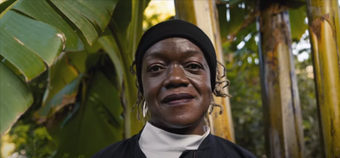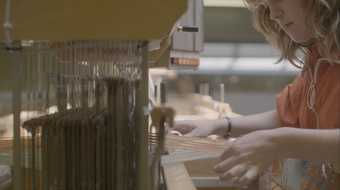Indian artist Monika Correa started weaving in 1962. She commissioned a carpenter to build a customised loom and has experimented with this practive ever since. Hear the artist talk about the thinking behind her artwork Original Sin 1972 and the effects that the process of weaving can produce.
The weaving I do isn't really accepted as art till recently, and they would think of weaving as craft.
This is my loom which is my prized possession.
It really presides over the living room and what's nice is that it looks like a wooden sculpture.
It's not like a painting. A painting you have a canvas in front of you and you know exactly what you want to do.
While in weaving, it's a very slow method and I have to do it carefully. So there's a lot of abstraction. I work upside down, inside out and that's how it works.
My husband Charles Correa was an Indian architect and planner. So, he really did a lot for India. We did support each other very much.
Charles would take a lot of interest in my work and I would in his too. Because we travelled a lot together.
It was a trip to Helsinki and then we went on to Boston.
And in Boston I looked out for someone who would help me weave because I was stunned by the weaving in Helsinki.
I'd never seen anything like that before.
The wool, the technique, and it was abstract weaving and when we got to Boston, it just happened that there was Marianne Strengell who had retired from Cranbrook Academy.
So, there she was and she said, why don't you come to Connecticut and I'll teach you how to weave?
So, I went there a couple of times and the second time she gave me the design of her loom, which I brought back to India and I got it fabricated here.
Well, that started me off.
And the fact that I didn't do a two-year course, a three-year course was very good because it allowed me to experiment.
This is the reed which has got tar on either side, but the teeth are like teeth of a comb and the threads go through it to keep it very structured.
But when I don't want it structured, I take this reed off. And how did I do that?
I got the carpenter to cut off one side of it, so then I can pull it out and have the reed meander along whichever way it wants.
In India it was very difficult really for women in the ceramic and textile field. It was the breadwinner who would sit at the at the wheel.
And women would just be the ones who did the bobbin winding or helping with the dyes or something.
But the men wouldn't allow the women closer to the loom because they felt that when they got married, the women got married, they would carry away all the secrets of the trade.
It was post-independent India and here in Bombay the Weavers’ Service Center had Mrs. Jayakar as chairman.
That was wonderful because a lot of things were happening and I got to understand what another kind of weaving was about. It doesn't necessarily have to be the traditional weaving.
But I was very interested in weaving as an art form. So, I started off with the Weavers’ Service Center for about six months.
And that's when I started with the dhurries. A dhurrie is a floor rug without a pile. So it's just a very flat rug.
You don't ever get to see much of it except those six or eight inches that you’re weaving.
So, every now and again I would have to unroll the piece and take stock of what it was.
And sometimes I'd stop in the evening because I felt I needed to think about it. You know. Dream about it, I’d say.
I was asked for the Bombay Arts Festival and I was really doing a play of colour really at the bottom and then I had this big sun.
I was really fascinated by the circle.
And this one was the first one, and so I called it Original Sin.
Not that there's anything sinful about it, but it was just because it was the original one.
Now, it was very difficult for me to do the circle and I worked it on the reverse side.
It was the first one that I felt I had made a breakthrough. I'll be frank enough. I don't know that much about weaving so I could experiment, you know, and get my way.
So that I think was my forte really. Experimentation.
I think there's still very few weavers post me.


